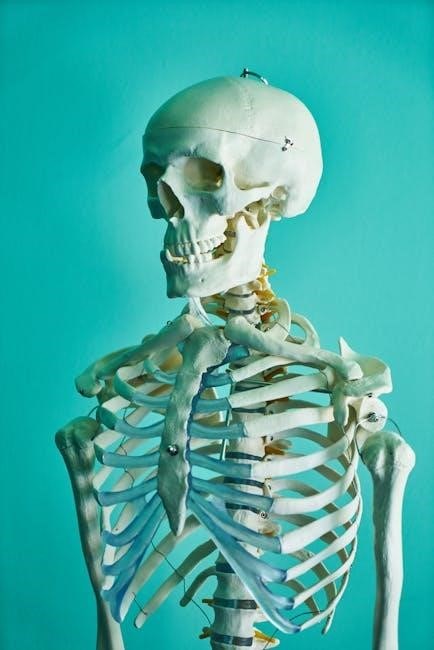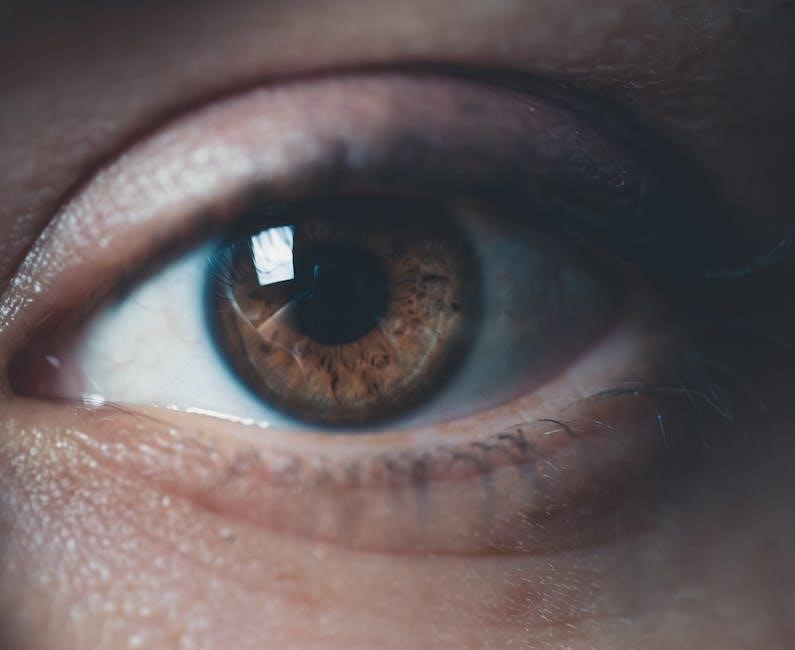Anatomy & Physiology Lab Manual: A Comprehensive Guide
The Anatomy & Physiology Lab Manual serves as a crucial tool‚ providing hands-on experience vital for understanding the complexities of the human body. These manuals offer step-by-step guides to dissection‚ identification of anatomical structures‚ and performance of laboratory procedures. They bridge theory with practical application‚ enhancing learning.
Anatomy & Physiology (A&P) lab manuals are indispensable resources for students embarking on a journey to understand the intricate workings of the human body. These manuals serve as practical companions to textbooks‚ offering hands-on experiences that solidify theoretical knowledge. They guide students through dissections‚ microscopic examinations‚ and physiological experiments‚ fostering a deeper comprehension of anatomical structures and their functions.
A well-structured A&P lab manual typically includes a variety of exercises designed to cover all major body systems. These exercises often involve identifying bones‚ muscles‚ and organs‚ as well as conducting experiments to explore reflexes‚ sensory perception‚ and other physiological processes. The manuals provide clear instructions‚ safety guidelines‚ and helpful diagrams to ensure students can perform the exercises effectively and safely. Furthermore‚ many modern A&P lab manuals incorporate digital resources‚ such as interactive simulations and virtual dissections‚ to enhance the learning experience.
The purpose of these manuals is to bridge the gap between textbook knowledge and real-world application. By actively engaging with anatomical specimens and physiological experiments‚ students develop critical thinking skills and problem-solving abilities‚ preparing them for future careers in healthcare and related fields.
Key Components of an Effective A&P Lab Manual

An effective Anatomy & Physiology (A&P) lab manual should possess several key components to facilitate optimal learning. Clarity in instructions is paramount‚ ensuring students can easily follow procedures without ambiguity. Each exercise should have well-defined objectives‚ outlining the specific learning outcomes expected. Comprehensive background information provides context‚ linking lab activities to theoretical concepts covered in lectures.

High-quality visuals‚ including detailed diagrams and photographs‚ are essential for accurate identification of anatomical structures. Safety protocols must be clearly emphasized to prevent accidents and ensure a secure learning environment. Interactive elements‚ such as fill-in-the-blank questions‚ labeling exercises‚ and critical thinking prompts‚ promote active engagement and reinforce understanding. Furthermore‚ a well-designed lab manual should incorporate opportunities for data collection‚ analysis‚ and interpretation‚ fostering scientific reasoning skills.
Integration of digital resources‚ like virtual dissections and simulations‚ can enhance the learning experience and provide access to materials beyond the physical lab setting. Finally‚ a comprehensive glossary of terms and appendices with supplementary information contribute to the manual’s overall value as a learning tool. These components collectively ensure that the A&P lab manual effectively supports students in mastering the subject matter.
Common Lab Exercises in A&P Manuals
Anatomy & Physiology (A&P) lab manuals typically include a variety of exercises designed to provide hands-on learning experiences. Microscopic examination of tissues‚ or histology‚ is a common exercise‚ where students identify different tissue types and their structural features. Another frequent lab involves bone identification‚ requiring students to recognize various bones of the skeletal system and their articulations.
Muscle identification and functional analysis are also prevalent‚ tasking students with identifying major muscles and understanding their roles in movement. Nervous system labs often include reflex testing and sensory perception experiments‚ allowing students to explore neural pathways and sensory receptors. Dissections‚ whether of animal organs or preserved specimens‚ offer invaluable opportunities to visualize anatomical structures in three dimensions. Cardiovascular system labs may involve blood pressure measurement‚ electrocardiography (ECG)‚ and analysis of blood components;
Respiratory system labs can include spirometry to assess lung function and microscopic examination of lung tissue. Endocrine system labs might focus on identifying endocrine glands and understanding hormone actions. Finally‚ reproductive system labs often involve the study of reproductive organs and gametogenesis. These diverse exercises aim to reinforce theoretical knowledge and develop practical skills essential for understanding the complexity of the human body. The A&P lab manual integrates these activities effectively.
Histology Labs: Microscopic Examination of Tissues
Histology labs in Anatomy & Physiology (A&P) manuals are crucial for understanding the microscopic structure of tissues‚ which form the foundation of organs and systems. These labs involve preparing and examining tissue samples under a microscope to identify different cell types and their arrangements. Students learn to distinguish between the four primary tissue types: epithelial‚ connective‚ muscle‚ and nervous tissue‚ each with unique characteristics and functions.
Epithelial tissue labs focus on identifying various types such as squamous‚ cuboidal‚ and columnar epithelium‚ and their specialized features like cilia or microvilli. Connective tissue labs cover a broad range‚ including loose and dense connective tissue‚ cartilage‚ bone‚ and blood‚ each with distinct cellular and matrix components. Muscle tissue labs involve differentiating between skeletal‚ smooth‚ and cardiac muscle based on their cellular structure and arrangement. Nervous tissue labs focus on identifying neurons and glial cells‚ the fundamental units of the nervous system.
Through these labs‚ students develop skills in slide preparation‚ staining techniques‚ and microscopic observation. They learn to correlate tissue structure with function‚ understanding how cellular arrangements contribute to the overall physiology of organs. Histology labs provide a foundational understanding necessary for comprehending more complex anatomical and physiological concepts in A&P.
Skeletal System Labs: Bone Identification and Articulations

Skeletal System Labs in Anatomy & Physiology (A&P) manuals are fundamental for understanding the structure and function of bones‚ the framework of the human body. These labs focus on identifying individual bones‚ their landmarks‚ and how they articulate to form joints. Students learn to differentiate between various bone types‚ including long bones‚ short bones‚ flat bones‚ and irregular bones‚ each adapted for specific functions.
Bone identification exercises involve examining real or plastic bone specimens to locate key features such as processes‚ fossae‚ foramina‚ and condyles. Students use anatomical terminology to describe these landmarks accurately. Articulation studies explore how bones connect at joints‚ focusing on the types of joints (e.g.‚ fibrous‚ cartilaginous‚ synovial) and their ranges of motion. These labs often include activities where students manipulate skeletal models to demonstrate movements like flexion‚ extension‚ abduction‚ and adduction;
Additionally‚ students may learn about bone development and remodeling‚ understanding how bones grow and adapt to mechanical stresses. They gain insights into common skeletal disorders and injuries‚ such as fractures‚ dislocations‚ and arthritis. By the end of these labs‚ students should be able to identify bones‚ describe their articulations‚ and appreciate the skeletal system’s role in support‚ movement‚ and protection.
Muscular System Labs: Muscle Identification and Function
Muscular System Labs are a cornerstone of Anatomy & Physiology lab manuals‚ providing essential hands-on experience in understanding the structure and function of human muscles. These labs emphasize muscle identification‚ origin‚ insertion‚ and action‚ enabling students to correlate anatomical features with physiological function. Students learn to distinguish different muscle types—skeletal‚ smooth‚ and cardiac—focusing primarily on skeletal muscles due to their role in movement.
Muscle identification exercises involve dissecting animal specimens or using anatomical models to locate specific muscles. Students learn to identify muscles based on their size‚ shape‚ location‚ and fiber direction. Understanding the origin and insertion points of muscles is crucial for predicting their actions. Students analyze how muscles work in groups to produce movements‚ considering the roles of agonists‚ antagonists‚ synergists‚ and fixators.
Furthermore‚ these labs often explore muscle physiology‚ including muscle contraction mechanisms‚ factors affecting muscle force‚ and the effects of exercise on muscle tissue. Students may perform experiments to measure muscle fatigue‚ examine the effects of different stimuli on muscle contraction‚ or analyze the microscopic structure of muscle fibers. By the end of these labs‚ students should be able to identify major muscles‚ explain their functions‚ and appreciate the muscular system’s role in movement‚ posture‚ and heat production.
Nervous System Labs: Reflexes and Sensory Perception
Nervous System Labs in Anatomy & Physiology manuals provide crucial insights into neural pathways and sensory mechanisms. These labs emphasize reflexes‚ automatic responses to stimuli‚ and sensory perception‚ the process by which the nervous system receives and interprets sensory information. Students explore the components of a reflex arc‚ including sensory receptors‚ afferent neurons‚ integration centers‚ efferent neurons‚ and effectors. Experiments often involve testing common reflexes such as the patellar (knee-jerk) reflex and the Achilles reflex to assess neural function.
Sensory perception labs delve into the various senses‚ including touch‚ temperature‚ pain‚ pressure‚ vision‚ hearing‚ taste‚ and smell. Students investigate the distribution and sensitivity of sensory receptors throughout the body. Vision labs may include tests for visual acuity‚ color vision‚ and depth perception‚ while hearing labs may explore sound localization and auditory discrimination.
Additionally‚ labs may cover the neural pathways involved in sensory perception‚ from the peripheral receptors to the sensory cortex in the brain. Students learn how the brain integrates sensory information to create a coherent perception of the environment. These labs often include dissections of animal brains or models of the human brain to identify key structures involved in sensory processing. Ultimately‚ these exercises aim to give students a comprehensive understanding of how the nervous system enables us to interact with our surroundings.
Integumentary System Labs: Skin Structure and Function
Integumentary System Labs within Anatomy & Physiology manuals offer hands-on exploration of the skin‚ its structures‚ and diverse functions. These labs focus on understanding the layers of the skin—epidermis‚ dermis‚ and hypodermis—and their respective components. Students typically examine prepared slides of skin tissue under a microscope to identify cell types such as keratinocytes‚ melanocytes‚ and immune cells like Langerhans cells. They also investigate dermal structures‚ including hair follicles‚ sebaceous glands‚ sweat glands (eccrine and apocrine)‚ and sensory receptors.
Functional aspects are explored through various experiments. Students may perform tests to evaluate tactile discrimination‚ temperature sensitivity‚ and pain perception‚ mapping the distribution of sensory receptors on different skin regions. The role of the skin in thermoregulation is examined through activities that demonstrate sweating and its cooling effect.
Labs also cover clinical correlations‚ such as examining skin conditions like psoriasis or eczema to understand how disruptions in skin structure can lead to disease. Students might also investigate the effects of UV radiation on the skin and the importance of melanin in protecting against sun damage. These exercises provide a comprehensive understanding of the skin’s role in protection‚ sensation‚ thermoregulation‚ and overall homeostasis.
Sensory System Labs: Exploring the Senses
Sensory System Labs in Anatomy & Physiology manuals provide an engaging exploration of how humans perceive the world through sight‚ hearing‚ taste‚ smell‚ and touch. These labs focus on the anatomy and physiology of sensory organs and their neural pathways. For vision‚ students often dissect a cow eye to identify structures like the retina‚ lens‚ and optic nerve. They might also conduct experiments to test visual acuity‚ color perception‚ and depth perception using Snellen charts and color blindness tests.
Auditory labs involve examining ear models and conducting hearing tests using tuning forks or audiometers to assess sound localization and frequency discrimination. Taste and smell are explored through experiments where students identify different tastes and odors‚ correlating them with the distribution of taste buds on the tongue and olfactory receptors in the nasal cavity.
Tactile sensation is investigated by mapping receptive fields on the skin and assessing sensitivity to touch‚ pressure‚ temperature‚ and pain. Reflexes‚ such as the pupillary light reflex and the knee-jerk reflex‚ are also examined to demonstrate the integration of sensory input and motor output. These labs provide a comprehensive understanding of how sensory information is detected‚ processed‚ and interpreted by the nervous system.
Digital Resources and eLabs in A&P Education
Digital resources and eLabs are transforming Anatomy & Physiology education‚ providing interactive and engaging alternatives to traditional lab experiences. These resources often include virtual dissections‚ 3D anatomical models‚ and simulated experiments that allow students to explore the human body in detail without the need for physical specimens. eLabs offer simulated lab environments where students can perform experiments‚ manipulate variables‚ and observe results in a controlled setting.
Interactive simulations can enhance understanding of complex physiological processes‚ such as nerve impulse transmission‚ muscle contraction‚ and cardiovascular function. Students can visualize these processes at a microscopic level and manipulate parameters to see the effects on system behavior. Digital resources also provide opportunities for self-paced learning and assessment‚ with interactive quizzes‚ animations‚ and videos that reinforce key concepts.
Furthermore‚ digital tools can make A&P education more accessible and affordable‚ reducing the need for expensive lab equipment and cadavers. Many online platforms also offer virtual microscopy‚ allowing students to examine histological slides and identify tissues and cells remotely. These technologies enhance learning outcomes by providing students with a more immersive and flexible educational experience.
Choosing the Right A&P Lab Manual
Selecting the right Anatomy & Physiology lab manual is a crucial step for both students and instructors. The ideal manual should align with the course’s learning objectives and provide clear‚ concise instructions for each exercise. Consider the level of detail provided‚ ensuring it matches the students’ background knowledge and the course’s depth.
Look for manuals that offer a variety of exercises‚ covering all major body systems and incorporating both anatomical and physiological concepts. The inclusion of high-quality illustrations and diagrams is essential for visualizing structures and understanding complex processes. Safety guidelines and proper disposal procedures should also be clearly outlined in the manual.

Instructors should evaluate whether the manual complements the textbook used in the course and if it offers supplemental resources like online simulations or interactive quizzes. Student feedback and reviews can provide valuable insights into the manual’s effectiveness and usability. Finally‚ consider the cost of the manual and whether digital versions are available to reduce expenses and promote accessibility. A well-chosen lab manual will greatly enhance the learning experience.
